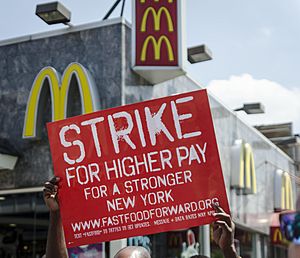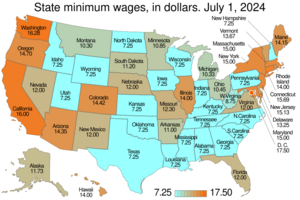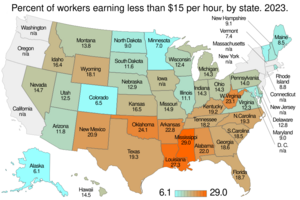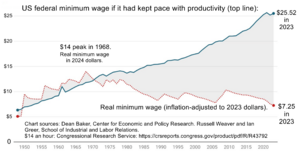Fight for $15 facts for kids

The Fight for $15 is a big movement in the United States. It wants to raise the minimum wage to USD$15 per hour. The minimum wage is the lowest amount of money an employer can legally pay workers. The federal minimum wage in the U.S. was last set at $7.25 per hour in 2009.
This movement began in 2012. Workers felt they couldn't afford basic needs on such low pay. They also faced tough working conditions in many service jobs. The movement has included strikes by people working in child care, home healthcare, airports, gas stations, convenience stores, and fast food restaurants. They wanted higher pay and the right to form a labor union. A union is a group of workers who join together to protect their rights and improve their working conditions.
The Fight for $15 has had many successes in different states and cities. California was the first state to pass a law in 2016 to raise its minimum wage. Alaska and Missouri were the most recent states to do so in 2024. Now, fifteen states and Washington, D.C. have laws to slowly increase their state minimum wage to at least $15 per hour. Four more states are expected to reach $15 by 2027 because of inflation adjustments. This means nearly half the country will have a $15 minimum wage by 2027. However, twenty states, with 37% of the population, are still at the federal minimum wage.
Big cities like San Francisco, New York City, and Seattle raised their local minimum wages to $15 earlier. This was because the cost of living in these cities is much higher. At the national level, the idea of a $15 minimum wage has become very popular among Democratic politicians. It was added to their party's goals in 2016 after Bernie Sanders supported it during his presidential campaign.
In 2019, the House of Representatives, which was controlled by Democrats, passed the Raise the Wage Act. This bill would have slowly raised the federal minimum wage to $15 per hour. But the Senate, which was controlled by Republicans, did not vote on it. In January 2021, Democrats in both the Senate and House brought the bill back. In February 2021, the Congressional Budget Office (CBO) studied the bill. They estimated that raising the federal minimum wage to $15 an hour by 2025 would help 17 million workers. However, it might also lead to 1.4 million fewer jobs. On February 27, 2021, the House passed a pandemic relief package called the American Rescue Plan Act of 2021. This package included the $15 minimum wage increase. But this part was removed from the Senate's version of the bill.
Contents
Strikes and Protests in the United States
On November 29, 2012, over 100 fast-food workers in New York City went on strike. They worked at places like McDonald's, Burger King, Wendy's, and Pizza Hut. They walked off their jobs to demand higher wages, better working conditions, and the right to form a union. Many workers were earning the minimum wage. Some were even making less than the minimum wage because of wage theft. Wage theft happens when employers illegally don't pay workers all the money they've earned.
This was the biggest strike ever in the fast-food industry. Earning less than a living wage meant many fast-food workers had to work multiple jobs. They also needed government help, like food stamps, to afford food, housing, and clothes. A "living wage" is the amount of money needed to cover basic living expenses. This first strike gained public attention because of concerns about economic inequality (when some people have a lot more money than others) in the U.S.
The strike was organized by several groups. On April 4, 2013, more than 200 fast-food workers went on strike again in New York City. This date was important because it was the 45th anniversary of the assassination of Martin Luther King Jr. during the Memphis sanitation strike. Hundreds of other workers also went on strike in cities like Chicago, Detroit, St. Louis, Milwaukee, and Seattle.
On July 29, about 2,200 workers went on strike in all the cities that had seen strikes before. New cities like Flint, Michigan, and Kansas City, Missouri, also joined.
A national fast-food strike happened on August 29. In Seattle, Washington, these protests helped convince a politician named Ed Murray to propose a plan for economic opportunity. This plan was later partly adopted by the Seattle city council. They voted to raise the minimum wage to $15.
On December 6, 2013, more fast-food strikes happened across the country. The goal was still to raise the minimum wage to $15 per hour.
On September 4, 2014, another national strike took place in over 150 cities. This time, thousands of Home care workers joined the fast-food workers. Organizers also changed their methods. They encouraged acts of civil disobedience, like sit ins, to get more attention. Sit-ins are when people protest by sitting down and refusing to move. Between 159 and 436 people were arrested.
On December 4, 2014, thousands of fast-food workers walked off their jobs in 190 U.S. cities. They continued to protest for $15 an hour and the right to have a union. Caregivers, airport workers, and employees at discount and convenience stores joined them. The strikes were also fueled by anger over police actions. Protesters chanted "15 and a union" along with "Hands up, don't shoot" and "I can't breathe." Organizers from Black Lives Matter supported the strike.
On April 15, 2015, tens of thousands of low-wage workers protested in over 200 cities. Labor organizers called it the largest protest by low-wage workers in U.S. history. Fast-food workers were joined by home care assistants, Walmart workers, child-care aides, airport workers, and others. A professor named Gary Chaison noted that this movement is special. He said it's about helping workers who are struggling, not just union members protecting themselves. He compared it to the civil rights movement.
Another strike happened in November 2015. U.S. Senator Bernie Sanders supported the striking workers and the idea of a $15 federal minimum wage at a rally in Washington D.C.

Global Strikes and Protests
On May 15, 2014, fast-food workers in many countries around the world went on strike. This included Brazil, the United Kingdom, Japan, and the U.S. They protested low wages in fast-food restaurants. The strikes happened in 230 cities. Workers demanded a $15 minimum wage and the right to form unions without fear of being punished.
Less than a week later, a large protest took place at McDonald's headquarters in Oak Brook, Illinois. Over 100 protesters were arrested, including workers and church leaders. This caused a partial shutdown of the McDonald's campus. According to organizers, protests also happened in 30 cities in Japan, 5 cities in Brazil, 3 cities in India, and 20 cities in Britain. A large labor group with over 12 million workers in 126 countries joined the protest to help the effort.
Some industry officials say that only a small number of fast-food jobs pay the minimum wage. They also say these are mostly entry-level jobs for workers under 25. But supporters of the movement point to studies showing that the average age of fast-food workers is 29. More than one-fourth of them are parents raising children.
According to Mary Kay Henry, president of a service employees union, fast-food workers worldwide face similar problems. These include low pay, no guaranteed hours, and no benefits. She believes this unfairness exists because workers cannot easily form unions. One McDonald's worker said the minimum wage was not enough to care for his kids and their education. However, some experts who disagree say that increasing wages could lead to fewer jobs.
In the United Kingdom, protesters carried signs saying "Fast Food Rights" and "Hungry for Justice." They chanted "Zero Hours, No Way." This referred to contracts that don't guarantee workers any hours but expect them to come in whenever called. In the Philippines, workers held a flash mob inside a McDonald's. They sang and danced to "Let It Go" from the movie Frozen. They urged McDonald's to "let go" of low wages and allow workers to organize. Protesters in Brussels shut down a McDonald's at lunchtime. In Mumbai, protesters continued even when threatened with arrest. Japan saw protests in almost every area. They showed support for U.S. workers by asking McDonald's to pay Japanese workers 1,500 yen.
This was not the first time workers protested low wages. On November 29, 2012, about 200 workers protested at a McDonald's in New York City. They chanted "Hey, hey, what do you say? We demand fair pay." According to Kate Bronfenbrenner, a labor expert, global worker campaigns are not new. Workers in Britain and India protested together in the 1800s against how the East India Company treated its Indian workers.
Some economists and labor activists look to Denmark's system. In Denmark, unions are strong, and fast-food workers earn living wages. This shows that companies can still make a profit even with high minimum wages. John Schmitt said, "We see from Denmark that it's possible to run a profitable fast-food business while paying workers these kinds of wages." However, Stephen J. Caldeira, who represents many fast-food companies, disagrees. He says comparing Denmark and the U.S. is like "comparing apples to autos."
A study in January 2015 by economists at the University of Massachusetts at Amherst found that fast-food companies could handle a wage increase from $7.25 to $15. They believed companies could do this without cutting jobs by reducing how often workers quit and by slightly raising prices. However, in Denmark, where wages are higher, there are fewer employees per restaurant, and more jobs are done by machines.

Affected Industries
Restaurant Industry
The restaurant industry is a main focus of the Fight for $15 movement. This is because restaurants and other food services employ about 60% of all workers paid at or below the minimum wage. When the minimum wage goes up, restaurants often cut employee hours or raise menu prices. In cities like New York City and Seattle, where a $15 minimum wage is already in place, menu prices have increased. Politicians, economists, and restaurant owners continue to discuss if a $15 federal minimum wage is good for the economy.
Economists from the Economic Policy Institute generally support a $15 federal minimum wage. Their plan suggests a slow increase, reaching $15 by 2024. They argue that fast-food restaurants could handle this wage increase. They believe it would lead to fewer workers quitting, more sales growth, and small yearly price increases. This would allow the wage bump without forcing restaurants to cut employees. Most supporters agree that prices might rise. But they believe this won't greatly harm dining or overall sales. They also point to research showing that minimum wage increases have a very small effect on the number of jobs.
A common argument against raising the minimum wage in restaurants to $15 is that it could lead to fewer employee hours. It might also cause layoffs (when workers lose their jobs) or restaurant closures.
Some food service workers, like waiters and bartenders, earn most of their money from tips. They might be paid a lower "tipped minimum wage," which is currently $2.13 an hour federally. A "tip credit" is the difference between their minimum wage and the cash wage they are paid. This accounts for tips that don't add up to the full minimum wage. Many supporters of a $15 minimum wage, including some restaurant owners, believe that restaurants should get rid of the tip credit system. They think it doesn't help low-wage restaurant workers.
Retail
In 2018, over 11 million workers in the retail industry were paid hourly rates at or below the federal minimum wage. Retail workers make up a large part of those affected by the minimum wage. Big stores like Target and Walmart are a key focus. Recently, some companies, including Target and Best Buy, have decided to raise their starting hourly wage to $15 an hour. They did this even without local or federal laws requiring it. As pressure grows, more stores are increasing their hourly rates. This helps meet political and social demands. It also benefits them by having happier, more productive workers.
Health Care
Health care is one of the largest industries in the United States. It had about 18.6 million workers in 2019, and these numbers are growing. In 2019, nearly 7 million people in the U.S. had low-paying health jobs. The average wage for jobs in health care support and direct care was $13.48 an hour. Doctors and nurses earn much higher pay. Because of this difference, the fight for a living wage in health care has gained support.
Achievements
In the state of Washington, two cities have been like test cases for the $15 minimum wage. In SeaTac, a small town near the Seattle–Tacoma International Airport, the minimum wage was raised to $15 per hour in 2014 all at once. This got a lot of media attention. In 2014, Seattle became the first major city in the U.S. to raise its minimum wage to $15 per hour. This effort was led by city council member Kshama Sawant. She had support from many groups, including labor unions and faith groups. Seattle's minimum wage for large employers reached $15.45 in 2018 and $16 in 2019. Studies of Seattle's workers have shown no decrease in jobs and clear benefits for workers.
The Fight for $15 movement has successfully raised the minimum wage to $15 or more per hour in several states and cities. In California, the minimum wage has been raised step-by-step since 2016. It started at $10 per hour and reached $15 per hour in 2022. Several cities in California have already raised their minimum wage to $15 or more. These include Berkeley, El Cerrito, Emeryville, Mountain View, San Francisco, San Jose, San Mateo, and Sunnyvale.
Massachusetts passed a law in 2018 that raises the state minimum wage to $15 per hour by 2023. This happened through yearly increases from the $11/hour minimum reached in 2017. The state of New York raised the minimum wage in the Downstate region to $15 per hour in 2021. In Upstate New York, the minimum wage is set by the Commissioner of Labor and is no lower than $12.50 per hour. In New Jersey, the minimum wage reached $15 per hour in 2024. In March 2019, both Maryland and Illinois passed laws to slowly raise their state minimum wage to at least $15 per hour over several years. In May 2019, Connecticut passed a $15 per hour law.
On November 3, 2020, 61% of Florida voters passed Amendment 2. This raised the minimum wage to $10.00 per hour starting September 30, 2021. It then increases by $1.00 per hour each year until it reaches $15.00 per hour in 2026. After that, it will be adjusted yearly for inflation. In 2022, Hawaii passed a law to raise the minimum wage to $18 per hour by 2028. This happens by increasing it by $2 every two years. Also in 2022, 59% of Nebraska voters passed Initiative 433. This raises the minimum wage to $15 per hour by 2026, increasing by $1.50 a year.
When New York State announced that the minimum wage in New York City would be raised to $15 an hour by December 31, 2018, many saw it as a direct result of the Fight for $15 protests. It showed how the movement started by fast-food workers in New York City led to higher wages across the country.
A $15/hour minimum wage at Amazon started in November 2018.
It is estimated that because of state and local minimum wage laws passed since the Fight for $15 began, about 26 million workers have received $151 billion in raises.
Exceptions
Sometimes, states and local governments that raise their minimum wage to $15 per hour include exceptions. This means some employers can pay less, or some types of employees receive less. This is usually done to try and avoid any possible negative effects on the economy.
Employers and industries with labor unions are sometimes allowed to pay less than the full minimum wage. This is done to encourage the growth of organized labor (unions). As of December 2014, unions were exempt from recent minimum wage increases in Chicago, SeaTac, Washington, and Milwaukee County, Wisconsin. This was also true in California cities like Los Angeles, Long Beach, San Jose, Richmond, and Oakland. In San Francisco, a labor union might be exempt if its collective bargaining agreement (a contract between the union and employer) specifically says it doesn't have to follow the minimum wage rule.
In New Jersey, where the general minimum wage reached $15 per hour in 2024, farmworkers are an exception. Their minimum wage is set at $12.50.
Estimated Economic Impact of Federal $15 Wage
In February 2021, the Congressional Budget Office (CBO) released a report on the Raise the Wage Act of 2021. They estimated that slowly raising the federal minimum wage to $15 an hour by 2025 would help 17 million workers. However, it might also lead to 1.4 million fewer jobs. The report also suggested it would lift 0.9 million people out of poverty. It could also raise wages for another 10 million workers. The CBO estimated it would increase the federal budget deficit (when the government spends more money than it takes in) by $54 billion over ten years. This is because the cost of goods and services paid for by the federal government would increase. It might also cause prices to rise and overall economic output to decrease slightly over the next 10 years.
A few economists have disagreed with some of the report's findings. University of California, Berkeley's Michael Reich estimated that a $15 minimum wage could actually increase federal tax revenue by $65 billion each year. This would happen because of increased payroll taxes and less government spending on safety net programs. Arindrajit Dube thought the report's review of studies wasn't as complete as his own. He estimated that job losses would be less than 500,000.
See also
- List of countries by minimum wage
- Income inequality in the United States
- Justice for Workers (Canadian movement)
- Labor history of the United States
- One Fair Wage
- Poverty in the United States
- McDonald's and unions





